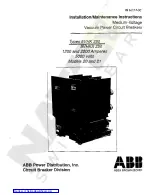
Effective 10/2004
Page 34
I.L. 70C1036H05
The type of data includes the total number of all Instanta-
neous and Short Delay trips seen by the circuit breaker.
A second counter shows the number of Overloads (LDT)
and Ground Faults (GFT) encountered while in service. The
OP count provides data on the number of Close Operations
experienced by the circuit breaker. The internal TEST
function will not increment the INST/SD or the LDT/GFT
counters, however, there will be count values in these
registers from the factory primary injection testing. Each of
these three values can be zeroed by depressing the Reset
pushbutton. These counters will roll over at a value of 255.
The last time the circuit breaker was operated (open or
closed or tripped) is viewable with time and date displayed.
Also included is the maximum temperature in degrees
Centigrade as seen by the Digitrip microprocessor CHip.
(For Screen Presentations See Appendix D-24)
The capture of the data requires external Trip Unit power.
This data, once captured, is stored in non volatile memory.
These features are available to PowerNet communications
utilizing Digitrip firmware Rev. F or higher.
NOTE:
Rev. F firmware permits maximum temperature to
be reset.
5.0 TEST PROCEDURES
5.1 General
WARNING
DO NOT ATTEMPT TO INSTALL, TEST, OR PERFORM
MAINTENANCE ON EQUIPMENT WHILE IT IS ENER-
GIZED. DEATH OR SEVERE PERSONAL INJURY
CANRESULT FROM CONTACT WITH ENERGIZED
EQUIPMENT.
DE-ENERGIZE THE CIRCUIT AND DISCONNECT THE
CIRCUIT BREAKER BEFORE PERFORMING MAINTE-
NANCE OR TESTS.
WARNING
ANY TRIPPING OPERATION WILL CAUSE DISRUPTION
OF SERVICE AND POSSIBLE PERSONAL INJURY,
RESULTING IN THE UNNECESSARY SWITCHING OF
CONNECTED EQUIPMENT.
CAUTION
TESTING A CIRCUIT BREAKER WHILE IT IS IN-SER-
VICE AND CARRYING LOAD CURRENT IS
NOT
RECOM-
MENDED.
TESTING OF A CIRCUIT BREAKER THAT RESULTS IN
THE TRIPPING OF THE CIRCUIT BREAKER SHOULD
BE DONE ONLY WITH THE CIRCUIT BREAKER IN THE
TEST OR DISCONNECTED CELL POSITIONS OR
WHILE THE CIRCUIT BREAKER IS ON A TEST BENCH.
5.2 When to Test
Testing prior to start-up can best be accomplished with the
circuit breaker out of its cell or in the Test, Disconnected,
or Withdrawn (or Removed) cell positions.
NOTE:
Since time-current settings are based on desired
system coordination and protection schemes, the protec-
tion settings selected and preset in accordance with
Section 4 should be reset to their as-found conditions if
altered during any routine test sequence.
Enter the Test menu and using the Edit Up/Down
pushbuttons, set the desired test current level. A test level
chosen above a setting will cause a pickup/trip condition. If
a pickup is not exceeded, the unit will remain in a “testing”
mode for three hours or until interrupted by a real event or
user pushbutton activity.
(See Appendix D-20 for
pushbutton sequence to conduct the testing. Press Save
twice to initiate the test.)
To conduct this testing as well as
viewing setting (if applicable), a small Auxiliary Power
Module, Cat. No. #PRTAAPM, is available for these
functions. This Module is an intermittent duty device that is
powered via 120 VAC, 50/60 Hertz and will plug into the
upper right corner of the product
(See Figure 1.1).
When performing a trip unit self test in TRIP mode,
tripping
of the circuit breaker and
activation
of the
associated Alarm or Accessory Bus relays can occur. This
is important to consider before initiating a test, since a
circuit breaker or relay action can initiate other equipment
responses in the system even if the circuit breaker is in
test position of a switchgear cell. The one exception to this
is the Ground Trip self test function of the LSIA style unit.
A Ground TRIP test will not actually trip the circuit breaker
but will only provide alarm display information and alarm
relay operation (if enabled).
In the NON-TRIP mode of self test, the circuit breaker trip
function and any associated relay will not operate when
test alarm or test trips occur. The front panel indicating
LED will light as well as display alarm/trip cause and trip
time information.









































